Overview
- Brief Narrative
- Scrip, valued at 10 cents, distributed in Deggendorf displaced persons camp in the American zone of Germany, after November 5, 1945, and saved by Carl Atkin, former director of the camp. Under his direction, the camp opened a canteen to purchase items, introduced a currency with which to buy said products, and set up a banking system. Prior to the end of World War II in 1945, Carl accepted a post with the United Nations Relief and Rehabilitation Administration (UNRRA), an international humanitarian organization. On August 23, 1945, he led UNRRA Team 55 to the poorly run Deggendorf displaced persons camp in the American-occupied zone of Germany, where they took over management. Carl and his team stabilized the food supply, secured housing facilities, fostered cultural life with lectures, concerts, performances, and established a community newspaper. Praised for his leadership, improvement of living conditions, and boosting of morale at Deggendorf, he left his directorship in December 1945, and was appointed UNRRA’s Coordinator of Jewish Affairs. In March 1946, he returned to the US, rejoined his family in Los Angeles, and continued to work for the organization. On July 2, 1947, UNRRA terminated its activities and Carl transitioned into sales and advertising, financial management for a nightclub that he co-owned, and eventually aerospace production, management and documentation.
- Date
-
issue:
after 1945 November 05
acquired: after 1945 November 05-before 1945 December
- Geography
-
issue:
Deggendorf (Displaced persons camp);
Deggendorf (Germany)
acquired: Deggendorf (Displaced persons camp); Deggendorf (Germany)
- Credit Line
- United States Holocaust Memorial Museum Collection, Gift of Richard Katz
- Markings
- face, center, printed, red ink : TEN CENTS / * / DEGGENDORF / JEWISH COMMUNITY / TREASURER
face, upper left corner, printed, red ink : 10
face, upper right corner, printed, red ink : 10
face, lower right corner, printed, red ink : 10
face, lower left corner, printed, red ink : 10
reverse, center, printed, red ink : TEN CENTS
reverse, upper left corner, printed, red ink : 10
reverse, upper right corner, printed, red ink : 10
reverse, lower right corner, printed, red ink : 10
reverse, lower left corner, printed, red ink : 10 - Contributor
-
Subject:
Carl Atkin
Issuer: Deggendorf Jewish Committee
- Biography
-
Carl Atkin (1903-1976) was born in Brooklyn, New York, to Russian immigrants and had an older brother, Jacob (b. 1898- ?). He attended New York City public schools, graduating in 1922. Shortly thereafter, he married Frances Ruthenberg (1904-1969) and had two children. In his early career, Carl worked as a house painter, a newspaper reporter for the Standard News Association, and a publicity manager for the Coney Island Publicity Bureau. Following the attack on Pearl Harbor on December 7, 1941, the United States declared war on Japan and by December 11, Nazi Germany declared war on the United States. When Carl registered for selective service in February 1942 he was working for the Office of Emergency Management in Washington, D.C. He was not chosen to join the fighting, and instead worked as a property and supply officer for the U.S. Treasury Department’s San Francisco and Los Angeles offices.
In the spring of 1945, Carl applied for a post with the United Nations Relief and Rehabilitation Administration (UNRRA), an international humanitarian organization established to help countries left economically devastated and the people displaced during World War II. The organization was established in November 1943, and began administering displaced persons (DP) camps in the Middle East in May 1944. After the war ended in May 1945, the UNRRA assumed management of the DP assembly centers and camps in the French, British, and U.S. Zones in Germany and helped to repatriate millions of people.
Carl joined the UNRRA and reported for training in Washington, D.C. on April 12, 1945. Leaving his family behind, Carl arrived in England on June 1 and continued on to a U.N. staging area in Heidelberg, Germany. On August 23, he led UNRRA Team 55 to Deggendorf, a former concentration camp turned displaced persons camp, in the American-occupied zone of Germany. When Carl’s team took over Deggendorf was largely populated by former inmates of Theresienstadt ghetto-labor camp and was poorly managed with overcrowding, poor living conditions and sanitation, as well as a lack of food and clothing. As camp director, Carl’s top priorities became stabilizing the food supply and securing housing facilities. He addressed the issue of overcrowding by reducing the number of refugees allowed in the camp. He also fostered the democratic election of a committee and self-administration within the camp. He improved physical infrastructure by providing new technical equipment such as central heating and water heaters, created a new large bathhouse, repaired sanitary systems, and generally enhanced dwelling conditions. Under his direction the camp opened a canteen to purchase items, introduced a currency with which to buy said products, and set up a banking system. Carl and his team also fostered cultural life with lectures, concerts, performances, and the creation of a community newspaper, in which he wrote a weekly column titled “Community Spirit.” Praised for his leadership, improvement of living conditions, and boosting of morale at Deggendorf, he left his directorship in December 1945 for an appointment as the UNRRA’s Coordinator of Jewish Affairs. Prior to his departure from Deggendorf, the Jewish Community gifted him a memory book reflecting on the progress made during his brief tenure and praising him for his advocacy and efforts on the community’s behalf. They threw him a farewell party in combination with a wedding celebration, where he served as best man. In his new role Carl traveled to numerous DP camps consulting on many of the improvements he had encouraged at Deggendorf including, the introduction of self-governments, monetary systems, and educational facilities.
In March 1946, he returned to the U.S. and joined his family in Los Angeles and continued to work for UNRRA. By then, most liberated countries had functioning governments once again, and on July 2, 1947 the UNRRA ended operations. Carl transitioned into sales and advertising, as well as financial management for a nightclub that he co-owned. In 1951, he returned to his Jewish assistance efforts, joining the American Financial and Development Corporation for Israel, which had been established in 1950 and was headquartered in Los Angeles, to help raise funds for the devastated Israeli economy following the country’s War of Independence (1947-1949). In May 1951, Israel’s first Prime Minister, David Ben-Gurion, visited LA for the inauguration of the State of Israel Bond Issue. In 1952, Carl transitioned into aerospace production management and documentation. In 1969, Carl’s wife, Frances died. In 1972, he married Edith J. Katz (nee Forman, 1912-1999) and became stepfather to her son, Richard (b. around 1936).
Physical Details
- Language
- English
- Classification
-
Exchange Media
- Category
-
Money
- Object Type
-
Scrip (aat)
- Genre/Form
- Money.
- Physical Description
- Deggendorf scrip printed on rectangular, off-white paper in red ink. On the face is a border of wavy lines and inside each corner is a square with the denomination. In the center are 4 lines of text and a small red star; in the lower right corner is a handwritten signature in black ink and a hand stamp in purple ink. The stamp consists of a ring with text surrounding a smaller circle with 3 lines of text inside. The reverse has a line of text in the center and the denomination in numerals in each corner. There is a crease on the left edge.
- Dimensions
- overall: Height: 2.375 inches (6.033 cm) | Width: 3.500 inches (8.89 cm)
- Materials
- overall : paper, ink
- Inscription
- Face, lower right corner, stamped, purple ink : Jewish Committee / D. P. / Camp 7 / . . .dorf
Face, lower right corner, signed, black ink : [illegible]
Rights & Restrictions
- Conditions on Access
- No restrictions on access
- Conditions on Use
- No restrictions on use
Keywords & Subjects
- Topical Term
- World War, 1939-1945--Civilian relief--Germany--Deggendorf. World War, 1939-1945--Refugees--Germany--Deggendorf. Zionism and Judaism. Zionists. Bonds Israel. Paper money--Germany--History. Displaced Persons Operations of the United Nations Relief and Rehabilitation Administration.
- Geographic Name
- Israel. Los Angeles (Calif.) Deggendorf (Germany)
Administrative Notes
- Legal Status
- Permanent Collection
- Provenance
- The scrip was donated to the United States Holocaust Memorial Museum in 2007 by Richard Katz, stepson of Carl Atkin.
- Funding Note
- The cataloging of this artifact has been supported by a grant from the Conference on Jewish Material Claims Against Germany.
- Record last modified:
- 2023-10-16 14:10:25
- This page:
- https://collections.ushmm.org/search/catalog/irn538652
Download & Licensing
In-Person Research
- By Appointment
- Request 21 Days in Advance of Visit
- Plan a Research Visit
- Request to See This Object
Contact Us
Also in Carl Atkin collection
The collection consists of photographs, artwork, documents, a ribbon, and scrip relating to the experiences of Carl Atkin’s work after the Holocaust with the UNRRA and later at the American Financial and Development Corporation for Israel.
Date: 1945 August 23-1969

Carl Atkin papers
Document
The Carl Atkins papers comprise documents and photographs related to the his work as the United Nations Relief and Rehabilitation Administration director of the Deggendorf displaced persons camp between 1945 and 1946. Materials include an illustrated song book, clippings from the camp’s newspaper, Deggendorf Center Revue, and a memory book created by members of the camp for Carl upon his departure in 1946. Several of Atkin’s identification cards are also included here, as are biographical materials, including a resume and partial memoir. The photographs in this collection include images of General Dwight D. Eisenhower and General Joseph T. McNarny’s visit sometime around 1945. The Carl Atkins papers comprise documents and photographs related to the his work as the United Nations Relief and Rehabilitation Administration director of the Deggendorf displaced persons camp between 1945 and 1946. Materials regarding the camp include an illustrated song book, clippings from the camp’s newspaper, Deggendorf Center Revue, and a memory book created by members of the camp for Atkin upon his departure in 1946. The book is titled “A Memory of Good Friendship in Hard Days” and includes several illustrations and chapters describing Atkin’s contributions to improving the camp conditions and bettering the refugees’ quality of life. The book describes in great detail the various mechanisms that he had put into place to aid the survivors as well as many statistics about the survivors themselves. Several of Atkin’s identification cards are also comprised here within, including a military entry permit and his certificate of registration. Correspondence relating to his assignment and departure as the director of Deggendorf is also included, as is a statement that he made regarding the specific needs of Jewish Holocaust survivors in the period immediately following their liberation. The photographs in this collection depict the camp, presumably during Atkin’s tenure as director, and include images of General Dwight D. Eisenhower and General Joseph T. McNarny’s visit sometime around 1945, children in the camp, and other visitors. Among the biographical materials in this collection are awards Carl won, clippings about him and his humanitarian work in the years beyond his service with the UNRRA, his resume, and one page of a memoir he started.
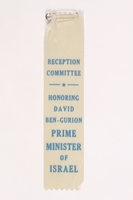
Commemorative ribbon worn by a director of the Deggendorf DP camp
Object
Commemorative ribbon worn by Carl Atkin for a reception dinner for Israeli Prime Minister, David Ben-Gurion held in Los Angeles, California, in 1951. Following Israel’s War of Independence (1947-1949), Ben-Gurion turned to American Jewish leaders to help him raise funds by issuing bonds. After the launch of these bonds, he traveled to Los Angeles, California, in 1951, where he was hosted by the Los Angeles Committee for the State of Israel Bonds and the American Financial and Development Corporation for Israel, where Carl Atkin worked. Prior to the end of World War II in 1945, Carl accepted a post with the United Nations Relief and Rehabilitation Administration (UNRRA), an international humanitarian organization. On August 23, 1945, he led UNRRA Team 55 to the poorly run Deggendorf displaced persons camp in the American-occupied zone of Germany, where they took over management. Carl and his team stabilized the food supply, secured housing facilities, fostered cultural life with lectures, concerts, performances, and established a community newspaper. Praised for his leadership, improvement of living conditions, and boosting of morale at Deggendorf, he left his directorship in December 1945 to accept an appointment as UNRRA’s Coordinator of Jewish Affairs. In March 1946, he returned to the US, rejoined his family in Los Angeles, and continued to work for the organization. On July 2, 1947, UNRRA terminated its activities and Carl transitioned into sales and advertising, financial management for a nightclub that he co-owned, and eventually aerospace production, management and documentation.
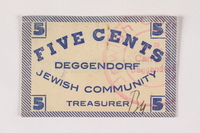
Deggendorf displaced persons camp scrip, 5-cent note, acquired by a former director
Object
Scrip, valued at 5 cents, distributed in Deggendorf displaced persons camp in the American zone of Germany, after November 5, 1945, and saved by Carl Atkin, former director of the camp. Under his direction, the camp opened a canteen to purchase items, introduced a currency with which to buy said products, and set up a banking system. Prior to the end of World War II in 1945, Carl accepted a post with the United Nations Relief and Rehabilitation Administration (UNRRA), an international humanitarian organization. On August 23, 1945, he led UNRRA Team 55 to the poorly run Deggendorf displaced persons camp in the American-occupied zone of Germany, where they took over management. Carl and his team stabilized the food supply, secured housing facilities, fostered cultural life with lectures, concerts, performances, and established a community newspaper. Praised for his leadership, improvement of living conditions, and boosting of morale at Deggendorf, he left his directorship in December 1945, and was appointed UNRRA’s Coordinator of Jewish Affairs. In March 1946, he returned to the US, rejoined his family in Los Angeles, and continued to work for the organization. On July 2, 1947, UNRRA terminated its activities and Carl transitioned into sales and advertising, financial management for a nightclub that he co-owned, and eventually aerospace production, management and documentation.
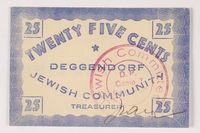
Deggendorf displaced persons camp scrip, 25-cent note, acquired by a former director
Object
Scrip, valued at 25 cents, distributed in Deggendorf displaced persons camp in the American zone of Germany, after November 5, 1945, and saved by Carl Atkin, former director of the camp. Under his direction, the camp opened a canteen to purchase items, introduced a currency with which to buy said products, and set up a banking system. Prior to the end of World War II in 1945, Carl accepted a post with the United Nations Relief and Rehabilitation Administration (UNRRA), an international humanitarian organization. On August 23, 1945, he led UNRRA Team 55 to the poorly run Deggendorf displaced persons camp in the American-occupied zone of Germany, where they took over management. Carl and his team stabilized the food supply, secured housing facilities, fostered cultural life with lectures, concerts, performances, and established a community newspaper. Praised for his leadership, improvement of living conditions, and boosting of morale at Deggendorf, he left his directorship in December 1945, and was appointed UNRRA’s Coordinator of Jewish Affairs. In March 1946, he returned to the US, rejoined his family in Los Angeles, and continued to work for the organization. On July 2, 1947, UNRRA terminated its activities and Carl transitioned into sales and advertising, financial management for a nightclub that he co-owned, and eventually aerospace production, management and documentation.
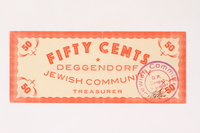
Deggendorf displaced persons camp scrip, 50-cent note, acquired by a former director
Object
Scrip, valued at 50 cents, distributed in Deggendorf displaced persons camp in the American zone of Germany, after November 5, 1945, and saved by Carl Atkin, former director of the camp. Under his direction, the camp opened a canteen to purchase items, introduced a currency with which to buy said products, and set up a banking system. Prior to the end of World War II in 1945, Carl accepted a post with the United Nations Relief and Rehabilitation Administration (UNRRA), an international humanitarian organization. On August 23, 1945, he led UNRRA Team 55 to the poorly run Deggendorf displaced persons camp in the American-occupied zone of Germany, where they took over management. Carl and his team stabilized the food supply, secured housing facilities, fostered cultural life with lectures, concerts, performances, and established a community newspaper. Praised for his leadership, improvement of living conditions, and boosting of morale at Deggendorf, he left his directorship in December 1945, and was appointed UNRRA’s Coordinator of Jewish Affairs. In March 1946, he returned to the US, rejoined his family in Los Angeles, and continued to work for the organization. On July 2, 1947, UNRRA terminated its activities and Carl transitioned into sales and advertising, financial management for a nightclub that he co-owned, and eventually aerospace production, management and documentation.
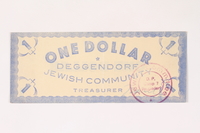
Deggendorf displaced persons camp scrip, 1-dollar note, acquired by a former director
Object
Scrip, valued at 1 dollar, distributed in Deggendorf displaced persons camp in the American zone of Germany, after November 5, 1945, and saved by Carl Atkin, former director of the camp. Under his direction, the camp opened a canteen to purchase items, introduced a currency with which to buy said products, and set up a banking system. Prior to the end of World War II in 1945, Carl accepted a post with the United Nations Relief and Rehabilitation Administration (UNRRA), an international humanitarian organization. On August 23, 1945, he led UNRRA Team 55 to the poorly run Deggendorf displaced persons camp in the American-occupied zone of Germany, where they took over management. Carl and his team stabilized the food supply, secured housing facilities, fostered cultural life with lectures, concerts, performances, and established a community newspaper. Praised for his leadership, improvement of living conditions, and boosting of morale at Deggendorf, he left his directorship in December 1945, and was appointed UNRRA’s Coordinator of Jewish Affairs. In March 1946, he returned to the US, rejoined his family in Los Angeles, and continued to work for the organization. On July 2, 1947, UNRRA terminated its activities and Carl transitioned into sales and advertising, financial management for a nightclub that he co-owned, and eventually aerospace production, management and documentation.
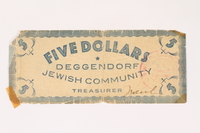
Deggendorf displaced persons camp scrip, 5-dollar note, acquired by a former director
Object
Scrip, valued at 5 dollars, distributed in Deggendorf displaced persons camp in the American zone of Germany, after November 5, 1945, and saved by Carl Atkin, former director of the camp. Under his direction, the camp opened a canteen to purchase items, introduced a currency with which to buy said products, and set up a banking system. Prior to the end of World War II in 1945, Carl accepted a post with the United Nations Relief and Rehabilitation Administration (UNRRA), an international humanitarian organization. On August 23, 1945, he led UNRRA Team 55 to the poorly run Deggendorf displaced persons camp in the American-occupied zone of Germany, where they took over management. Carl and his team stabilized the food supply, secured housing facilities, fostered cultural life with lectures, concerts, performances, and established a community newspaper. Praised for his leadership, improvement of living conditions, and boosting of morale at Deggendorf, he left his directorship in December 1945, and was appointed UNRRA’s Coordinator of Jewish Affairs. In March 1946, he returned to the US, rejoined his family in Los Angeles, and continued to work for the organization. On July 2, 1947, UNRRA terminated its activities and Carl transitioned into sales and advertising, financial management for a nightclub that he co-owned, and eventually aerospace production, management and documentation.
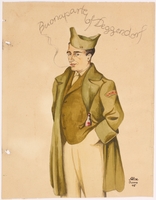
Watercolor portrait of Carl Atkin, former director of Deggendorf displaced persons camp
Object
Watercolor portrait of Carl Atkin, former director of Deggendorf displaced persons camp in the American zone of Germany, and created by Annemarie Loewe Durra in 1945. On August 9, 1945, Annemarie arrived at Deggendorf after she and many other former prisoners were transferred from Theresienstadt ghetto-labor camp where they had been imprisoned in German-occupied Czechoslovakia. There was an active cultural community at Deggendorf and Annemarie contributed illustrations to the Deggendorf Center Review, a newspaper issued by the camp’s Jewish Committee. Prior to the end of World War II in 1945, Carl accepted a post with the United Nations Relief and Rehabilitation Administration (UNRRA), an international humanitarian organization. On August 23, 1945, he led UNRRA Team 55 to the poorly run Deggendorf DP camp in the American-occupied zone of Germany, where they took over management. Carl and his team stabilized the food supply, secured housing facilities, fostered cultural life with lectures, concerts, and performances. Praised for his leadership, improvement of living conditions, and boosting of morale at Deggendorf, he left his directorship in December 1945, and was appointed UNRRA’s Coordinator of Jewish Affairs. In March 1946, he returned to the US, rejoined his family in Los Angeles, and continued to work for the organization. On July 2, 1947, UNRRA terminated its activities and Carl transitioned into sales and advertising, financial management for a nightclub that he co-owned, and eventually aerospace production management and documentation.



